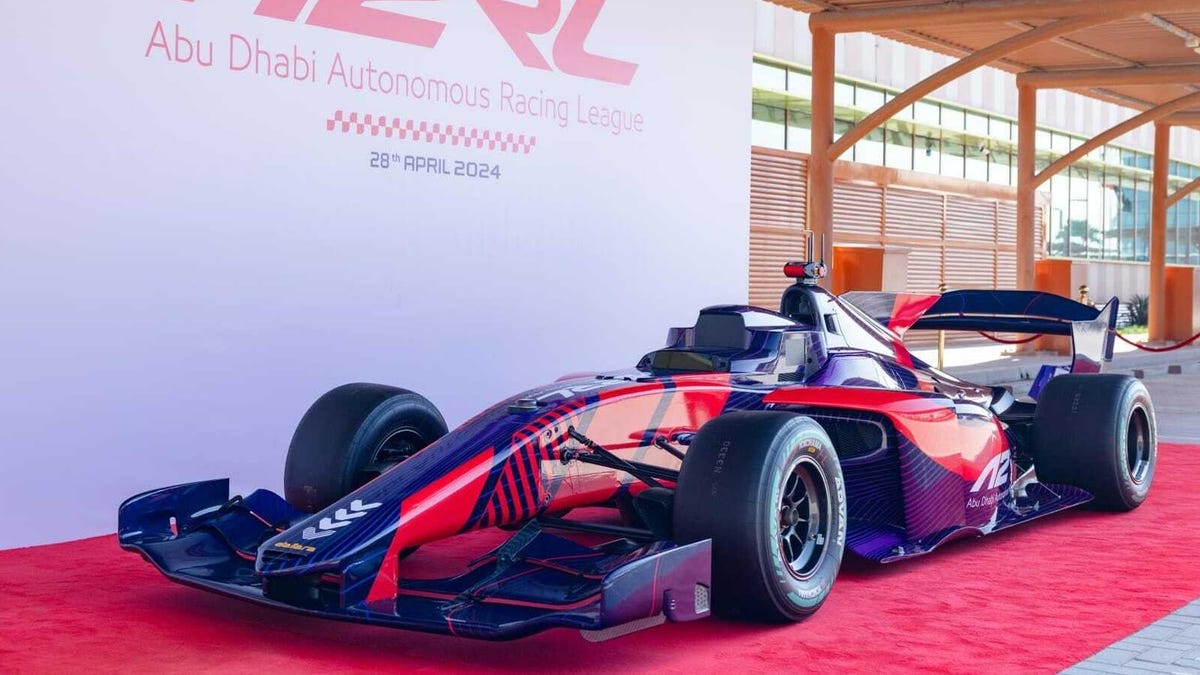A small handful of people in the world of motorsports might find reason to care about the concept of autonomous racing. In theory this could be a new opportunity for motorsport to return to its original purpose as a crucible of automotive technological improvement. In practice, it’s boring, half-assed, and deeply unimportant. This morning I was served an advertisement on Twitter reminding me that the Abu Dhabi Autonomous Racing League is supposed to stage its first race in a couple of months. Who asked for this?
There have been a couple of cynical attempts at getting an autonomous racing series off the ground. Likely the most well-known of them is Roborace, which kicked off in 2017 and died an ignominious death in 2022 after failing to actually, you know, race.
There were many things that Roborace got wrong, but one thing it did get right was building a car that actually looked like the future. The first generation of Robocar looked like an open wheel racer without a cockpit, which is exactly what it should be. Who needs a place for a driver to sit when these cars are intended to be driverless from the outset? If the racing isn’t going to be fast, and there aren’t any drivers to give the series personality, at least make the cars look interesting.
While self-driving technology has likely improved a bit since the 2020 incident which saw a single car wreck itself within the first three seconds of a live event, I don’t think it’ll ever catch on with fans. And there are three main reasons for that.
1. Autonomous Driving Is A Dead End
Automakers and tech nerds have been promising autonomous driving technology for much longer than I’ve been alive, and they’ll keep promising it long after I’m dead, but I’m convinced a car without a steering wheel won’t be practical in the lifetime of anyone reading this. There are way too many variables on a road for all driving to be taken over by computers. You can’t plan for every scenario, and it’s the edge cases where things get dangerous. Our roads are too terrible, too varied, and too unpredictable to ever fully concede the steering wheel to a robot.
2. Autonomous Racing Is Boring As Hell
Racing has a similar issue. While the circuit itself is easily predictable, and you can write algorithms to predict tire wear or weather-related traction, the true speed is often found by intuition. Is there enough computing power in the algorithm to know the exact moment to change to rain tires, or to save fuel, or to take advantage of a change in wind direction or cloud cover? Can a robot dig deep to find a hero lap?
So far the autonomous racing cars have been slow and unsure of themselves. They have done the same thing that lane keep assist technology did circa 2012, bouncing back and forth between the left and right hand lane lines. The cars themselves shake their invisible heads no, and racing fans followed right along with the same motion. It didn’t, won’t, and will never catch on.
3. Nobody Actually Wants To Watch Perfection
The best racing in the world is never about who can be the most perfect in the perfect conditions with the perfect car. To me, the best racing happens when someone finds a way to overcome adversity and push past the competition anyway. The mistakes are always the best part, because they show the reality of the thing. If a piece of computer code can calculate the fastest way around a track and do that exact same lap fifty times, where’s the fun in that?
Did anyone actually have fun watching Max Verstappen last year? Shit, maybe I’m wrong. Maybe Max Verstappen fans would love autonomous racing.
The Abu Dhabi Autonomous Racing League, confusingly calling itself A2RL, is a half-assed attempt at bringing autonomous racing to the world. The series uses an existing Dallara Super Formula chassis, which itself is a competent and fast racing car built for the Japanese series. These cars, with human drivers, are incredibly fast, capable of nearly F1-level lap times. A2RL doesn’t mention anything about the engines in the back of their spec Dallara chassis, but in Super Formula the teams can choose between Toyota or Honda 2-liter turbocharged four-cylinder race engines making around 550 horsepower.
Allegedly the car has completed a full week of autonomous testing at the Yas Marina circuit, and ten cars from teams around the world will have acces to the track for two weeks in the lead up to the series’ first race. These teams will then compete in a series of trials on April 28th to determine the series’ first champion.
I don’t see this one catching on. If it does, I’ll commit myself to eating one entire Dallara SF23 chassis. The series championship-winning team can choose to garnish it with a Honda Racing HR-417E or a Toyota TRD-01F engine, as they see fit.

